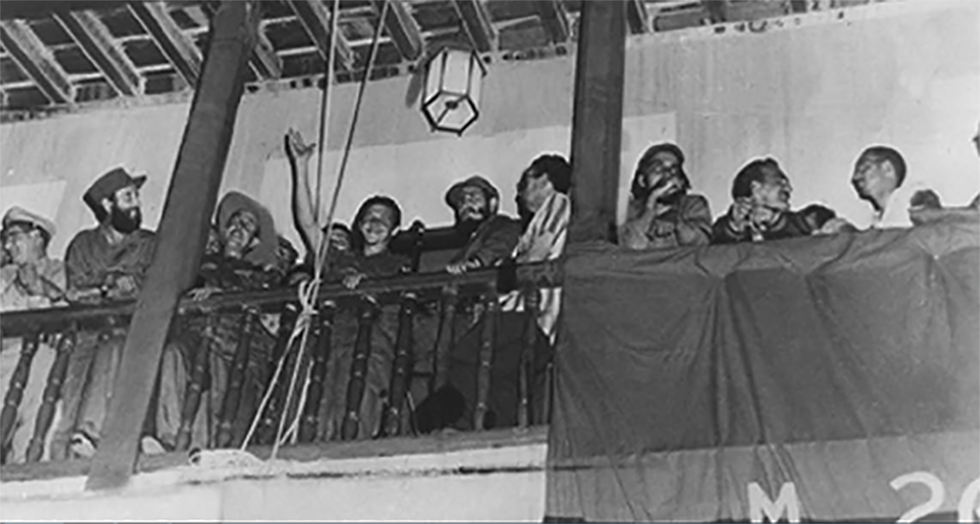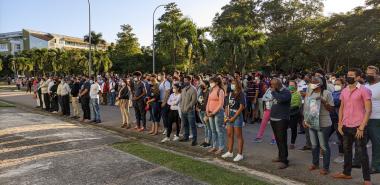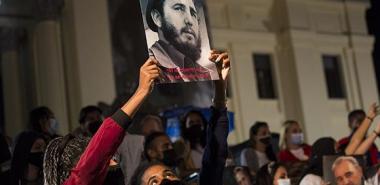On January first, 1959 from the balcony of the city hall, in Santiago of Cuba, Fidel next to his brother Raúl, communicated the Triumph of the Cuban Revolution.
Triumphal Entry on January First 1959.
On January first, 1959, Fidel and his Rebel Army entered in Santiago de Cuba, announcing the triumph of the Cuban Revolution, which marked the liberation of the Cuban people from imperialism and the implementation of socialism as an economic, political, social and cultural model. That day, from the balcony of the City Hall, in front of Cespedes' park, the leader announced that the final conquest of the independence of the country had been achieved.
The Rebel Army Columns commanded by Camilo Cienfuegos and Che Guevara had surrendered the Yaguajay and Santa Clara barracks, respectively, and set off, militarily strengthened, to the capital of the country to take the Columbia Camp and the Fortress of La Cabaña. From that moment the power was finally in the hands of the rebel forces.
The Cuban Revolution is a process that begins to take shape from the end of the XIX century, when the mambises frustrated attempt took place against the Spanish regime willing to achieve the independence of Cuba, in which the Liberating Army, showed their example of patriotism and courage, which were inherited by the young generation of mid-twentieth century.
The armed insurrection headed by Fidel Castro drove a new strategy against the dictatorship of the moment, and at last it led to the triumph of the Revolution which for 58 years have demonstrated the Cuban people's capacity, intelligence and the ability of the revolutionary leadership, as well as the correctness of the struggle of this country for its independence.
When on January 1959 the dictator Fulgencio Batista flees towards the USA , begins the only triumphant Revolution in Latin America that ended with the expropriation of the possessions of the bourgeoisie and landowners. A week later, on January 8th, a general strike defeated the maneuvers of the dictatorship that sought to wrest victory from the revolutionaries by creating a military meeting.
The Rebel Army is received on January 8th by large crowds in Havana. At that time, Cuba faced a serious situation due to the fall in the demand for sugar, the motor of the local economy, and the opening of a strong social crisis. The island lived in the social degradation resulting from imperialist domination. The capital was a large brothel where the Americans enjoyed themselves and the Mafia made big business.
The Revolution liquidated the Batista army leaving its place to the Rebel Army militias made up of rural peasants, workers and peasants, who will accompany the new power. This situation is frightening the bourgeoisie and the imperialist who at first looked with good eyes at the movement of the "bearded" from La Sierra, who, in the face of the advance of the Revolution, began to boycott the Government.
The 1959 Revolution taught that in order to achieve national liberation, the end of the latifundial and the resolution of the housing problem through urban reform, we must combat the bourgeoisie creole and destroy their repressive apparatus, expelling them from political power and expropriating their properties.
The Cuban Revolution was never able to develop its emancipatory potential for the criminal US blockade; But the workers 'and peasants' masses have managed to defend their main conquests with an independent policy.
The triumph of Cuba was a stimulus for the Latin American insurrectional left, which inspired the Cuban model tried to create rural guerrilla focuses for the conquest of power. The example was in Central America (Guatemala and Honduras), the Caribbean (the Dominican Republic), the Andes (Venezuela, Colombia, Ecuador, Peru or Bolivia) and in Brazil.
When the first day of January, 1959, Cuba started with the news of the flight of dictator Fulgencio Batista, it had been two years and 13 days since Commander-in-Chief Fidel Castro, with only seven rifles, to restart the armed struggle in the mountains of The Sierra Maestra.
Fidel, told the people on the First of January 1959:
"This time, fortunately for Cuba, the Revolution will really come to an end; It will not be like in 95, that the Americans came and took ownership of it, they [...] intervened at the last minute and then did not even let in Calixto García, who had fought for 30 years, not let him enter Santiago de Cuba ; It will not be like in 33, that when the people began to believe that the Revolution was being made, Mr. Batista came, betrayed the Revolution, seized power and established a ferocious dictatorship here; Will not be like in 44, year in which the crowds were inflamed believing that at last the town had come to the power. And those who came to power were thieves! No thieves, no traitors, no interventionists, this time it's a Revolution! "






